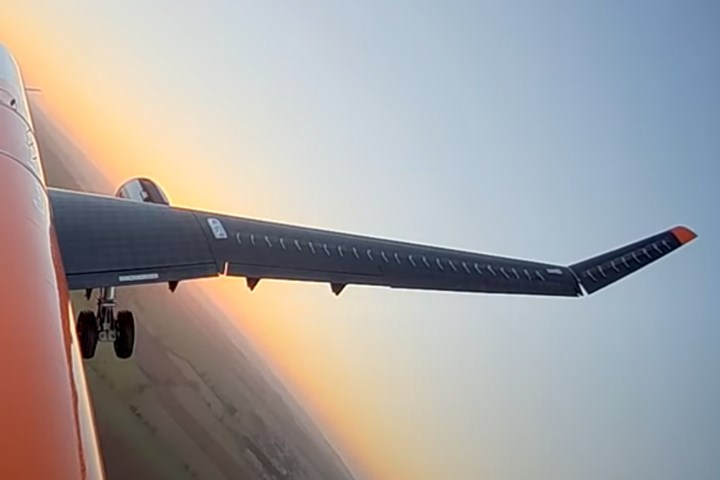
AlbatrossONE, small-scale demonstrator in flight with flapping wing tips. Photo Credit: Airbus
The AlbatrossONE demonstrator has successfully achieved a new milestone: a “gate-to-gate” demonstration with wing-tips that are 75% longer than those tested in the first phase. This latest flight test campaign proves freely flapping wing-tips can alleviate wing loads and avoid tip stall for improved aircraft performance.
As a seabird, the albatross has a lot to teach aeronautical engineers about improving aircraft performance. And the Airbus AlbatrossONE project team is taking note, putting the principles of freely flapping wing-tips — capable of reacting and flexing to wind gusts — to the test.
This small-scale, remote-controlled aircraft demonstrator, which features “semi-aeroelastic” hinged wing-tips, recently completed a successful second flight test campaign. Airbus Semi-Aeroelastic Hinge Project leader Tom Wilson and AlbatrossONE chief engineer James Kirk discuss the potential of this innovative technology for future aircraft.
Q. The AlbatrossONE project is inspired by the albatross seabird. How did this unique seabird inspire Airbus engineers?
Tom: The albatross’ wing-tips are actually somewhat analogous to semi-aeroelastic hinged wing-tips. The albatross can “lock” its wings at the shoulder to travel long distances, but when faced with wind gusts, it can “unlock” its shoulder to better navigate wind speeds. Semi-aeroelastic hinged wing-tips behave in the exact same way.
James: Also, as a neat coincidence, the semi-aeroelastic hinged wing-tips’ long span could have an aspect ratio (i.e. the wing span to its width or “chord”) of around 18 (versus 9 or 10 for today’s aircraft). This is exactly the same ratio as that of the largest albatrosses. Wing span and aspect ratio are important for reducing aerodynamic drag.
Q. What makes “semi-aeroelastic hinged wing-tips” so innovative?
James: Semi-aeroelastic hinged wing-tips enable an aircraft to “surf” through wind gusts without transferring the bending loads (i.e. external load that produces bending stresses within a body) to the main wing. This means we require less material, such as carbon fiber-reinforced polymers, to make the wing strong enough to withstand the gust loads, thus reducing the weight of the aircraft. Also, the length of the wing-tip can be extended without adding weight to the wing because the extra loads from the longer wing-tip are not passed to the main wing.
Q. How does this impact aircraft performance?
Tom: Semi-aeroelastic hinged wing-tips are remarkable because they would enable a step change in aircraft performance: a major increase in wing span with minimal impact on wing weight would reduce drag, leading to significant reductions in fuel burn and CO2 emissions. Lift-induced drag accounts for about 40% of a large aircraft’s drag. But this figure falls as the wing span increases. The semi-aeroelastic hinged wing-tips’ span could potentially be increased beyond 50 meters without increasing wing weight.
Q. The AlbatrossONE team completed a second flight test campaign in July 2020. What was the aim and what did you achieve?
James: Throughout 2019, we completed a series of innovative ground-based tests, which confirmed aspects such as mass properties, wing stall behavior and wing-tip release and recovery mechanisms. All of these tests were highly successful. Following a first flight test campaign, we conducted a second to successfully perform a “gate-to-gate” demonstration. This involves moving the wing-tips from vertical to horizontal position before flight, and back again after flight. We also enabled the wing-tips to flap just before lift-off to improve roll control and navigate a high load during flight. They were then locked into planar for efficient cruise.
Tom: The “gate-to-gate” demonstration also enabled us to prove freely flapping wing-tips can alleviate wing loads, while increasing roll rate compared to fixed-wing tips and avoiding tip stall during landing. During a separate flight, we also demonstrated how to safely land an aircraft using freely flapping wing-tips without hitting the ground or stops.
Q. Will the semi-aeroelastic hinged wing-tip concept be applied to future aircraft? And if so, when?
Tom: Now that proof-of-concept has been achieved at small scale, we’ll increase our efforts to mature the technology at a larger scale.
James: There’s still a lot of engineering work required before we can prove it’s a viable product. But the project team is motivated to achieve this goal and to inspire other engineers to think ambitiously about future aircraft!
Related Content
A new era for ceramic matrix composites
CMC is expanding, with new fiber production in Europe, faster processes and higher temperature materials enabling applications for industry, hypersonics and New Space.
Read MorePlant tour: Spirit AeroSystems, Belfast, Northern Ireland, U.K.
Purpose-built facility employs resin transfer infusion (RTI) and assembly technology to manufacture today’s composite A220 wings, and prepares for future new programs and production ramp-ups.
Read MorePEEK vs. PEKK vs. PAEK and continuous compression molding
Suppliers of thermoplastics and carbon fiber chime in regarding PEEK vs. PEKK, and now PAEK, as well as in-situ consolidation — the supply chain for thermoplastic tape composites continues to evolve.
Read MoreThe state of recycled carbon fiber
As the need for carbon fiber rises, can recycling fill the gap?
Read MoreRead Next
From the CW Archives: The tale of the thermoplastic cryotank
In 2006, guest columnist Bob Hartunian related the story of his efforts two decades prior, while at McDonnell Douglas, to develop a thermoplastic composite crytank for hydrogen storage. He learned a lot of lessons.
Read MoreComposites end markets: Energy (2024)
Composites are used widely in oil/gas, wind and other renewable energy applications. Despite market challenges, growth potential and innovation for composites continue.
Read MoreCW’s 2024 Top Shops survey offers new approach to benchmarking
Respondents that complete the survey by April 30, 2024, have the chance to be recognized as an honoree.
Read More


























